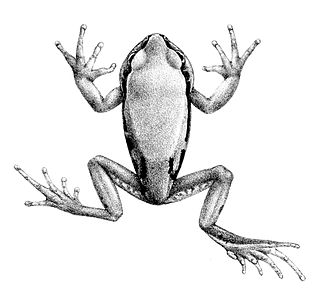
The tiger snake is a large and highly venomous snake of southern Australia, including its coastal islands and Tasmania. These snakes are often observed and locally well known by their banding, black and yellow like a tiger, although the species can be highly variable in colouration and patterning. All populations are classified within the genus Notechis (Elapidae). Their diverse characteristics have been classified either as distinct species or by subspecies and regional variation.

Indosylvirana temporalis, commonly known as the bronzed frog or Günther's golden-backed frog, is a species of true frog found in the riparian evergreen forests of the highlands of southwestern Sri Lanka. They are found abundantly on or close to the ground near water. Individuals are not shy and react by jumping only when provoked. They are important prey of many species of snakes, including the vine snake. Some related species found in the Western Ghats of India were formerly included in this species but were separated in a 2014 study.

Crinia is a genus of frog, native to Australia, and part of the family Myobatrachidae. It consists of small frogs, which are distributed throughout most of Australia, excluding the central arid regions. Many of the species within this genus are non-distinguishable through physical characteristics, and can only be distinguished by their calls.

The common eastern froglet is a very common, Australian ground-dwelling frog, of the family Myobatrachidae.

The striped marsh frog or brown-striped frog is a predominantly aquatic frog native to coastal Eastern Australia. It is a common species in urban habitats.

The Tasmanian froglet is a species of ground-dwelling frog that occurs only in Tasmania, Australia.

The wallum froglet is a species of ground-dwelling frog native to the east coast of Australia, from southeast Queensland to Kurnell, NSW. It is strongly associated with Wallum swampland.

Haswell's frog is a small ground frog found around coastal swamps in eastern Australia from around Port Macquarie, New South Wales to the Mornington Peninsula in Victoria. It is the only member of the genus Paracrinia.

The western chorus frog, also known as striped chorus frog, or midland chorus frog is a species of frog found in Canada and the United States.

Leptopelis vermiculatus, also known as the peacock tree frog, Amani forest treefrog, or vermiculated tree frog, is a species of frog found in forest areas in Tanzania. Sometimes the common name big-eyed tree frog is used, but this may also refer to another species, Leptopelis macrotis.

Spicospina is a genus of ground-dwelling frogs in the family Myobatrachidae. It is monotypic, being represented by the single species, Spicospina flammocaerulea, also known as the sunset frog. First discovered in the year 1994, it is native to south-western Western Australia. It is known from only 27 sites, all occurring east and northeast of Walpole.

The eastern sign-bearing froglet is a small, ground dwelling frog native to eastern Australia.
The streambank froglet or Flinders Ranges froglet is a small, locally common, Australian ground-dwelling frog, of the family Myobatrachidae.

The Copan brook frog is a species of frog in the family Hylidae found in northeastern Guatemala and northwestern Honduras, specifically in the Sierra del Merendón, Sierra de Omoa, Sierra de Caral, and Sierra Espíritu Santo ranges. The colouring of this species is very distinctive and the specific name soralia comes from the resemblance of its markings to the vegetative structures on some crustose lichens.

Leptopelis gramineus is a species of frog in the family Arthroleptidae. It is endemic to Ethiopia and occurs on the Ethiopian Highlands on both sides of the Great Rift Valley. Common names Badditu forest treefrog and Ethiopian burrowing tree frog have been coined for it.

The desert froglet, chirping froglet, or sparrow froglet is a species of frog in the family Myobatrachidae, endemic to Australia. Desert froglets occur mainly in dry or moist savanna habitats, principally from the mid-western border of Northern Territory, south-east into western Queensland and New South Wales and the north-east corner of South Australia. They can also be found along the Queensland coast where it has been recorded between Townsville and Cooktown, and as far south as Hervey Bay.

The quacking frog, also known as the red-thighed froglet due to its legs tending to be bright red, is a species of frog from the Myobatrachidae family and is in a clad with five other species. The frog is well known for the sound it produces which resembles a quack. It has up to 11 notes and can change the notes in their call. It has larger testes compared to other frogs within the genus and has started to be used in experiments. This frog is found in southwest Australia. It is found in ponds and pools and other moisture filled areas. These frogs engage in polyandry and can result in multiple paternity of its offspring. Additionally, the tadpoles of this species can change the rate they metamorphosize depending on the conditions. The males tend to have larger arm girth and can adopt different mating strategies depending on size. The mating strategy is dependent on male density. The frogs also vary in terms of colour and texture of its skin. The tadpoles are generally golden with transparent tails.

The moss froglet is a species of frog in the family Myobatrachidae. It is endemic to southern Tasmania.
















